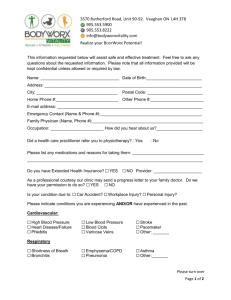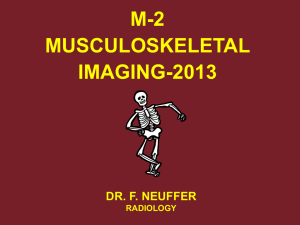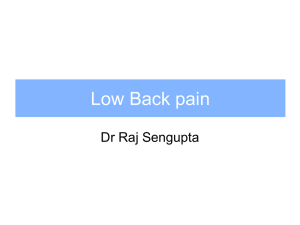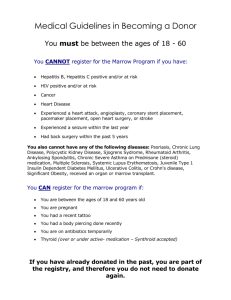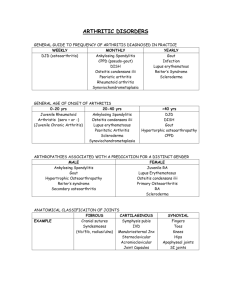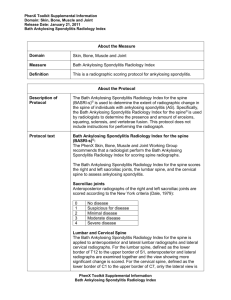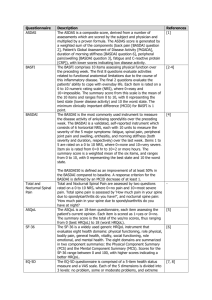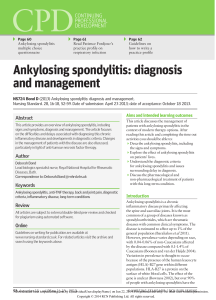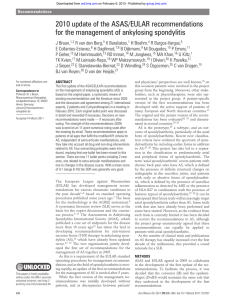Ankylosing Spondylitis
advertisement
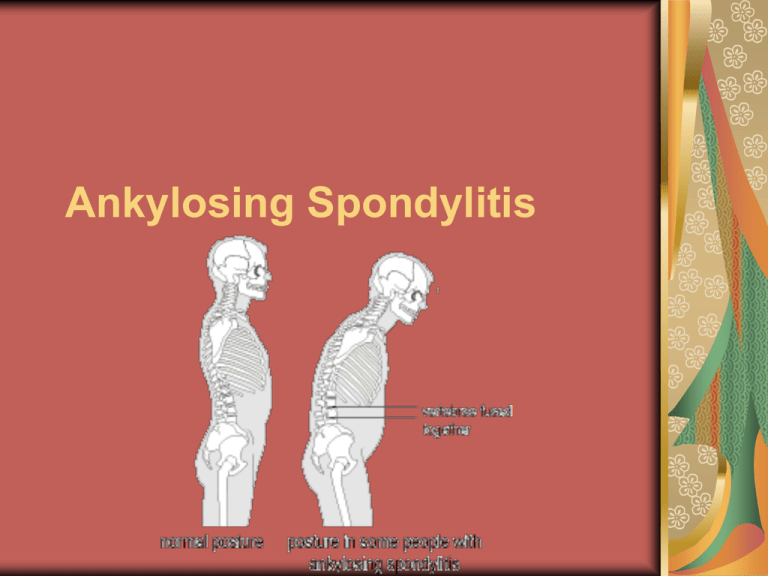
Ankylosing Spondylitis ETIOLOGY/ PATHOPHYSIOLOGY Ankylosing spondylitis is a form of arthritis that is long-lasting (chronic) and most often affects the spine . It can cause pain, stiffness, swelling, and limited motion in the low back, middle back, and neck, and sometimes areas such as the jaw, shoulders, hips, knees, and heels. Ankylosing spondylitis is more common in men than women. CLINICAL MANIFESTATIONS inflammation primarily of the joints of the spine, but it can also involve inflammation of the eye, other joints (especially the hips) on occasion, the heart, lungs, and chest wall. If the inflammation continues over time, it will lead to scarring and permanent damage. In some people, the disease is mild and progresses slowly, and symptoms never become severe. Other people may have a more aggressive disease process. Mild or early Ankylosing Spondylitis usually starts with dull pain in the low back and back stiffness. Some people have "flares" of increased pain and stiffness that may last for several weeks before decreasing again. Mild or early Ankylosing Spondylitis Affected bones of the low back, middle back, hips, or neck may become painful, stiff, and limited in motion. Pain tends to increase slowly over a period of weeks or months, and it is often hard to point to exactly where the pain is. Stiffness is usually worse in the morning. Physical activity often helps decrease pain and stiffness. Mild or early Ankylosing Spondylitis A feeling of tiredness is common as the disease progresses. This tiredness comes from the body fighting the inflammatory process that is part of ankylosing spondylitis, and from ongoing stiffness and pain. Mild or early Ankylosing Spondylitis The colored part of the eye (iris) may become inflamed. This inflammation, called iritis, occurs in about 25% to 30% of people with ankylosing spondylitis.Symptoms of iritis include redness and pain in the eye and sensitivity to light. Severe or advanced ankylosing spondylitis Scarring in the spine causes the joints of the spine to grow together (fuse, or "ankylose"). As the bones fuse , back pain will gradually go away, but the spine will remain very stiff and unable to bend. The fused spine is more likely to break. Severe or advanced ankylosing spondylitis The upper spine can curve forward until eventually the person has a hard time looking straight ahead. In addition, as the spine loses its natural curves it becomes hard to balance for standing and walking, especially if the hips are also affected. Severe or advanced ankylosing spondylitis Breathing can become difficult as the upper body curves forward and the chest wall stiffens. Severe ankylosing spondylitis can also cause scarring of the lungs (pulmonary fibrosis) and an increased risk of lung infection. This can cause even greater problems in smokers because their lungs are already more prone to lung infection and scarring. Severe or advanced ankylosing spondylitis Scarring in the eye can lead to permanent visual impairment and glaucoma. In rare cases, the heart muscle can become scarred and the heart valves may become inflamed. The heart may be unable to pump properly (heart failure). The main artery leading from the heart (aorta) can also be affected by becoming inflamed and enlarged near where it leaves the heart. DIAGNOSIS/TREATMENT X-rays of the spine and pelvis to check for bone changes (bony erosions, fusion, or calcification of the spine and sacroiliac joints). Certain changes in the sacroiliac joint confirm the diagnosis of ankylosing spondylitis, but those changes can take several years to develop enough to show on X-ray. MRI and ultrasound are both being studied as ways to diagnose ankylosing spondylitis earlier. DIAGNOSIS/TREATMENT A genetic test (through a blood test), which may be done to determine the presence of a particular gene (HLA-B27) that is often associated with ankylosing spondylitis. This test will not confirm whether you have ankylosing spondylitis. However, if you have the HLA-B27 gene, you could pass it along to your children. This would increase the chances they could get ankylosing spondylitis or one of the other spondyloarthropathies. DIAGNOSIS/TREATMENT You will have a physical exam to see how stiff your back is and whether you can expand your chest normally. Your doctor will also look for tender areas, especially over the points of the spine, the pelvis, the areas where your ribs join your breastbone, and your heels. INTERVENTIONS/TEACHING Reducing pain by taking pain relievers such as nonsteroidal anti-inflammatory drugs, or using heat to decrease your pain and stiffness. Warm showers or baths or sleeping under a warm electric blanket may reduce stiffness. Exercising regularly. This reduces pain and stiffness and helps maintain fitness and mobility of the spine, chest, and joints. Your doctor may recommend physical therapy to get you started on an exercise program. INTERVENTIONS/TEACHING Deep breathing exercises can improve or maintain lung capacity. Swimming as part of your exercise program helps to maintain chest expansion and movement of the spine without jarring the spine. Breast stroke is especially good for chest expansion. You should avoid contact sports, since joint fusion may make your spine more likely to fracture as the disease progresses, but your doctor may approve of other activities such as golf and tennis. INTERVENTIONS/TEACHING Maintaining proper posture and chest expansion. Good posture is important because it can help prevent abnormal bending of the spine . Maintaining chest expansion will help prevent problems such as lung infection (pneumonia). It's a good idea to lie on your stomach a few times each day to keep your spine and hips extended. For sleeping, choose a firm mattress and a small pillow that supports your neck. INTERVENTIONS/TEACHING Using assistive devices such as canes or walkers. Your local chapter of the Arthritis Foundation, your physical therapist, or a medical supply company may be able to help you find assistive devices in your area. If your neck is becoming stiff, your doctor may recommend that you wear a soft neck brace when you ride in the car, to prevent injury in case of an accident . INTERVENTIONS/TEACHING AVOID SMOKING SEE YOUR OPTHAMOLOGIS T FOR REGULAR EYE EXAMS JOINING A SUPPORT GROUP Pictures
